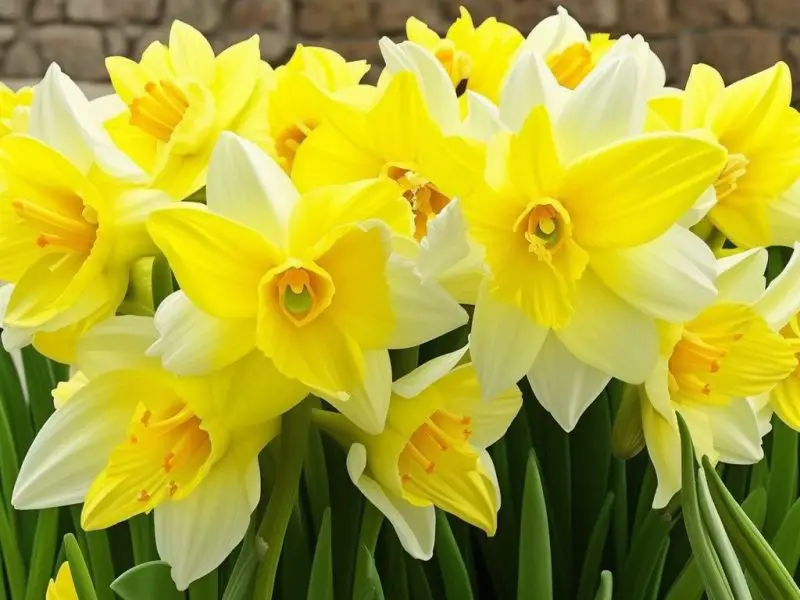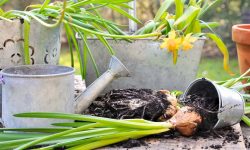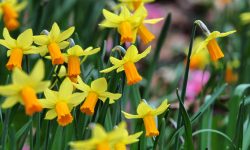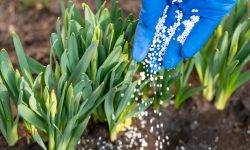Few sights capture the spirit of spring quite like the golden glow of daffodils swaying in the breeze. These cheerful flowers are among the first to announce winter’s end, brightening gardens, meadows, and city parks with vibrant color. But if you’ve ever wondered exactly when daffodils bloom, the answer isn’t always simple. Their flowering time depends on several factors — from variety and weather to soil conditions and sunlight exposure. Understanding these elements helps gardeners predict bloom time more accurately and enjoy a longer, healthier flowering season.
Knowing when daffodils bloom is more than curiosity; it’s key to proper care. By understanding how temperature, planting depth, and local climate influence blooming, you can plan a garden that bursts into color precisely when spring begins. This guide will explain when daffodils typically bloom, what affects their timing, and how to encourage earlier and longer-lasting blossoms in your garden.
Understanding the Daffodil Bloom Cycle

The daffodil bloom cycle is a fascinating process that follows the rhythm of the seasons. It begins long before spring arrives, deep beneath the soil. During fall, daffodil bulbs establish strong root systems, anchoring themselves for the colder months ahead. Throughout winter, while the garden appears lifeless, the bulbs remain quietly active underground, storing nutrients and preparing for their grand emergence. As temperatures begin to rise and daylight increases, the bulbs respond by sending up green shoots. This is the first visible sign that the blooming process has begun.
By early to mid-spring, daffodils enter their most spectacular stage — full bloom. During this period, stored nutrients and water are channeled upward to support stem elongation and flower formation. The bright yellow, white, or orange trumpets open in response to sunlight and mild temperatures, signaling that winter is truly over. Blooming generally lasts for two to four weeks, depending on weather conditions and bulb health. Adequate moisture, sunlight, and soil fertility during this time are essential for producing large, vibrant flowers.
After the blooming phase, daffodils begin their post-flowering recovery. The petals fade, and the plant directs its energy back into the bulb. The green foliage that remains plays a crucial role — through photosynthesis, it replenishes the bulb with carbohydrates needed for the next year’s growth. Once the leaves naturally yellow and die back, the bulb enters dormancy again. Understanding this life cycle helps gardeners time planting, watering, and fertilizing correctly, ensuring their daffodils return stronger and more beautiful each year.
When Do Daffodils Bloom in Different Regions
Northern Regions
In northern regions with long, cold winters, daffodils are among the earliest signs of spring. The bloom season typically begins between late March and mid-April, depending on how quickly the ground thaws. Bulbs remain dormant under frozen soil through winter, protected by their outer layers. Once temperatures consistently rise above freezing, shoots emerge and rapidly develop into flower buds. In areas like the northern United States, Canada, or northern Europe, daffodils may even push through a light dusting of snow before fully opening.
Because the growing window is short, daffodils in northern regions rely heavily on sunlight and moisture for successful blooming. Gardeners can extend the bloom period by planting early, mid, and late-season varieties together. This layered approach ensures continuous color across several weeks despite the short spring season. Mulching bulbs in fall also helps regulate soil temperature and promotes earlier sprouting once winter ends. With the right timing, northern daffodils provide an unforgettable burst of color after months of frost and silence.
Southern Regions
In southern regions with mild winters and early springs, daffodils often bloom as early as late January or February. The warmer soil allows bulbs to awaken sooner, giving southern gardens a head start on the season. However, early blooming also means greater sensitivity to sudden cold snaps or temperature fluctuations. Gardeners in states like Texas, Georgia, and Florida often see daffodils flowering well before northern regions have thawed. The duration of the bloom period tends to be longer, lasting up to five or six weeks under favorable conditions.
Because heat arrives quickly in southern climates, it’s important to plant bulbs deeper — about six to eight inches — to protect them from warm soil. Mulching can also help insulate bulbs and retain moisture. Daffodils benefit from partial shade during the hottest part of the day, which helps prolong flowering. In these regions, well-timed watering and early planting in fall are essential for healthy blooms. Properly managed, southern daffodils bring bright, cheerful color to gardens when most other plants are still dormant.
Coastal & Mild-Climate Regions
In coastal and mild-climate regions, daffodils often enjoy the longest and most stable blooming season. Areas such as the Pacific Northwest, coastal California, and parts of Western Europe provide cool, moist winters and gentle springs — ideal conditions for extended flowering. Here, daffodils typically bloom between February and April, with some varieties lasting into early May. The consistent temperatures and moderate rainfall allow bulbs to grow steadily without stress from sudden freezes or excessive heat.
Gardeners in these climates should focus on soil drainage and air circulation rather than temperature control. Coastal soils can be dense and hold too much moisture, leading to rot if not improved with compost or sand. Daffodils thrive in slightly elevated beds or borders that prevent waterlogging. Regular deadheading and maintaining moisture during blooming help flowers last longer. Coastal daffodils often naturalize easily, multiplying each year to form stunning displays that return reliably with minimal maintenance.
Factors That Affect Daffodil Blooming Time
Temperature and Climate
Temperature plays the most significant role in determining when daffodils bloom. These bulbs require a period of winter chill — usually between 35°F and 45°F (1–7°C) — to trigger proper flower development. In regions with mild winters, the chilling requirement may not be fully met, causing delayed or uneven blooming. Conversely, an unusually warm winter can lead to premature sprouting, exposing shoots to frost damage. Spring temperatures also influence bloom timing: warm days and cool nights encourage gradual opening, while sudden heat waves shorten the flowering period.
To ensure predictable blooming, gardeners should plant bulbs early enough in fall to allow root establishment before frost. In warmer areas, choosing heat-tolerant daffodil varieties like ‘Carlton’ or ‘Ice Follies’ helps maintain consistency. Mulching during winter can stabilize soil temperature and protect bulbs from extreme fluctuations. Understanding how temperature affects bulb physiology allows gardeners to anticipate bloom time more accurately and maintain vibrant flowers despite unpredictable seasonal shifts.
Soil and Moisture Conditions
Soil quality and moisture balance directly influence daffodil growth and flowering. Daffodils thrive in well-draining soil rich in organic matter. Heavy, compacted, or waterlogged soil restricts oxygen flow and promotes bulb rot, leading to stunted or failed blooms. Similarly, overly dry soil during root development can stress bulbs and delay flowering. Consistent, moderate moisture during early growth and bloom periods is essential to sustain energy and hydration for healthy stems and bright flowers.
Improving soil structure with compost, sand, or leaf mold ensures proper drainage and aeration. Water deeply once a week during active growth, especially in dry climates, but avoid letting bulbs sit in wet soil. Applying a thin mulch layer helps maintain consistent moisture and temperature. Balanced soil nutrition also matters — phosphorus and potassium support blooming, while excess nitrogen encourages leaf growth instead of flowers. Proper moisture management ensures daffodils bloom fully, with large, colorful petals and sturdy stems.
Variety and Planting Depth
Different daffodil varieties have distinct blooming times, ranging from early to late spring. Early-blooming types like ‘February Gold’ and ‘Tête-à-Tête’ open in late winter, while mid-season and late varieties such as ‘Dutch Master’ and ‘Salome’ bloom weeks later. Planting multiple varieties ensures a continuous display of color across several months. However, planting depth can significantly alter bloom timing as well. Bulbs planted too shallow may sprout early, risking frost damage, while deeper bulbs emerge later but with stronger stems.
For most daffodils, planting bulbs at a depth about three times their height — usually 6 inches — provides stability and ideal insulation. In warmer climates, planting slightly deeper helps bulbs avoid premature sprouting caused by warm surface soil. Consistent spacing also affects air circulation and nutrient access, both crucial for bloom quality. Understanding variety differences and adjusting planting depth properly gives gardeners greater control over bloom timing, helping daffodils flower uniformly and predictably each season.
How to Encourage Earlier and Longer Blooming
Encouraging daffodils to bloom earlier and last longer begins months before the first shoots appear. The secret lies in strategic planting and proper pre-winter care. Always plant bulbs early in the fall, roughly six weeks before the first frost. This timing gives bulbs ample opportunity to develop strong roots before temperatures drop. A well-established root system ensures they respond quickly to the first warmth of spring. Choose a spot with full sun exposure for at least six hours a day, since daffodils rely heavily on sunlight to initiate early blooming. In colder zones, apply a mulch layer two inches thick to insulate the bulbs from harsh freezes that could slow their growth. Early-blooming cultivars such as ‘Jetfire’ and ‘Rijnveld’s Early Sensation’ naturally open weeks ahead of other varieties.
To prolong blooming, create variety diversity within your garden. Mixing early, mid, and late-blooming types provides waves of color lasting up to eight weeks. Regular watering during growth and flowering is crucial, but the soil should never become waterlogged. Deadhead spent blooms promptly to prevent seed formation, directing energy back into the bulb for next year’s growth. Feeding daffodils with a balanced fertilizer rich in phosphorus and potassium before and after blooming enhances flower longevity and color intensity. For gardeners in windy regions, gentle staking or planting near protective structures helps prevent bent stems and damaged petals.
Maintaining healthy foliage after blooming is equally vital for sustained performance. Allow leaves to remain until they fade naturally, as this process restores essential nutrients to the bulb. If weather becomes too hot too quickly, partial shading using nearby plants or light fabric can extend bloom life by several days. With careful planning, balanced nutrition, and mindful protection, your daffodils will burst into color earlier and maintain their brilliance far longer than expected, rewarding your garden with unmatched spring charm.
Caring for Daffodils After Blooming Ends
When daffodils finish blooming, many gardeners assume their work is done — but the weeks following flowering are the most critical for next year’s success. Once the blooms fade, carefully remove the spent flowers by snipping just below the base. This prevents the plant from forming seeds and redirects energy back into the bulb. However, do not cut the green stems or leaves. These parts continue photosynthesizing, transforming sunlight into carbohydrates stored within the bulb. Healthy, intact foliage ensures strong, vigorous plants and larger blooms the following spring. Cutting the leaves too early can weaken bulbs and even prevent them from flowering next season.
Watering after blooming should continue for several weeks, especially in dry climates. Moist soil helps bulbs recover from flowering stress and recharge energy reserves. Apply a light, balanced fertilizer or a low-nitrogen formula to support nutrient replenishment without stimulating excess leaf growth. Avoid using high-nitrogen fertilizers, as they encourage foliage at the expense of bulb health. As the foliage naturally yellows and collapses, reduce watering gradually until the soil becomes dry. This signals the beginning of dormancy, a resting stage vital to bulb regeneration.
When the leaves are fully dry, remove them gently and decide whether to leave bulbs in the ground or lift them for storage. In well-drained soil and temperate climates, daffodils can remain undisturbed for several years. If lifting, clean bulbs carefully, let them dry in shade, and store them in a cool, dark, and ventilated area. Proper post-bloom care builds bulb strength, ensuring that daffodils return with even brighter, fuller blooms season after season.
Common Blooming Problems and How to Fix Them
Daffodils Not Blooming (Blindness)
One of the most common daffodil problems is “blindness,” where healthy leaves emerge, but flowers never appear. This usually results from overcrowded bulbs that compete for space and nutrients. When left undivided for too many years, bulbs grow smaller and weaker, losing their flowering ability. Shallow planting or nutrient-poor soil also disrupts the bulb’s growth cycle. Another common cause is premature foliage cutting, which prevents the bulb from storing enough energy for next year’s bloom. Insufficient sunlight or soggy soil further reduces bloom potential.
To fix this, lift and divide overcrowded clumps every three to five years, replanting bulbs deeper — about three times their height. Choose a sunny, well-drained location enriched with organic compost. After blooming, apply a balanced fertilizer high in phosphorus to encourage strong bud formation. Avoid overwatering and always allow leaves to yellow naturally before removing them. Proper spacing, nutrition, and post-bloom care will restore your daffodils’ health, ensuring full, colorful blooms return stronger in the next growing season.
Short or Drooping Stems
Short or drooping stems are often caused by insufficient sunlight, excessive nitrogen, or improper planting depth. Daffodils planted too shallowly develop weak root systems, making stems unable to support heavy flowers. Low light levels and nutrient imbalances also affect cell structure, leading to limp or stunted growth. Overfertilization, especially with nitrogen-based products, encourages soft, weak stems and excess leaf growth. Waterlogged soil or strong wind exposure can further worsen the problem, bending flowers before they fully open.
To correct this, plant bulbs at least 6 inches deep and space them properly to allow airflow. Ensure daffodils receive six hours of direct sunlight daily. Feed bulbs with fertilizer rich in phosphorus and potassium to strengthen tissue and promote sturdier stems. Mulching helps regulate soil temperature and maintain consistent moisture. In windy areas, plant daffodils near low shrubs, borders, or walls for natural protection. Providing proper depth, light, and nutrition will encourage upright, resilient stems and fuller flowers that last longer through the blooming season.
Uneven or Early Blooming
Uneven or premature blooming is another common issue that frustrates gardeners. It often occurs due to erratic temperature patterns, uneven moisture, or mismatched bulb varieties. A sudden warm spell in late winter can force early sprouting, leaving emerging shoots vulnerable to frost damage. If some bulbs are planted shallower or receive more sunlight, they may bloom ahead of others. Poor drainage or fungal stress during dormancy can also cause uneven growth rates and inconsistent flowering across the garden bed.
To fix this, plant bulbs of similar varieties and maturity together, ensuring equal sunlight and spacing. Apply a layer of mulch in late fall to regulate soil temperature and protect bulbs from sudden warming or frost. Maintain consistent watering during active growth, but keep the soil dry during dormancy to avoid fungal stress. Feeding bulbs at the same time every season supports synchronized development. Replacing weak or damaged bulbs also promotes uniform blooming. With proper temperature regulation, balanced moisture, and smart variety selection, your daffodils will bloom evenly, producing a striking and harmonious spring display.
Seasonal Care Tips for Consistent Blooming
Spring: Nurturing During Active Growth
Spring is the most active and vital stage in a daffodil’s yearly rhythm. As shoots emerge, provide consistent watering to keep the soil evenly moist but never soggy. Daffodils require at least six hours of sunlight daily for vigorous growth. Early spring is also the best time to apply a balanced, slow-release fertilizer low in nitrogen but rich in phosphorus and potassium to encourage strong roots and colorful blooms. Remove weeds promptly to prevent competition for nutrients, and loosen compacted soil if needed to enhance aeration and moisture absorption.
Once the flowers open, deadhead them as they fade to direct the plant’s energy back into the bulb instead of seed formation. Continue watering for several weeks after blooming, as this supports photosynthesis within the green leaves. Never tie or cut foliage prematurely — allow it to yellow and die back naturally. This stage allows the plant to replenish the bulb with nutrients for next spring. Proper spring care ensures healthier bulbs, stronger roots, and more abundant blossoms that return reliably each year.
Summer: Allowing Dormancy and Rest
Summer represents a time of recovery and dormancy for daffodils. After flowering and foliage dieback, gradually reduce watering and allow the soil to dry out naturally. Daffodil bulbs rest underground during this season, conserving energy for next year’s growth. Overwatering during dormancy can lead to bulb rot or fungal infection, especially in clay-heavy soils. In regions with frequent summer rain, cover planting areas with a thin mulch or compost layer to regulate moisture levels. This helps bulbs remain cool and dry without becoming waterlogged.
Mid to late summer is also the ideal time to lift and divide overcrowded bulbs. Use a garden fork to gently remove them, brush off excess soil, and inspect for signs of damage or decay. Let healthy bulbs dry in a shaded, airy spot for one to two days before replanting or storing them in mesh bags. Store bulbs in a cool, dry, and well-ventilated area until fall planting. Providing rest and dryness during summer ensures bulbs recover their strength, leading to larger and more vibrant blooms next season.
Fall: Root Establishment and Preparation
Fall marks a new beginning for daffodils as temperatures cool and soil conditions become ideal for root development. Planting bulbs in early to mid-fall allows them to settle before winter frost. Choose a location with well-drained soil and full sunlight to promote healthy root growth. Enrich the soil with organic matter such as compost or aged leaf mold before planting. Plant bulbs six inches deep and four inches apart, positioning them with their pointed ends facing up. Water thoroughly after planting to eliminate air pockets and stimulate root activity.
In cooler regions, apply a two-inch mulch layer to help regulate soil temperature and moisture levels. Avoid high-nitrogen fertilizers, as they promote leafy growth instead of strong bulbs. Instead, use a phosphorus-rich fertilizer that supports early root formation. If replanting divided bulbs, discard any soft or discolored ones before placing them in fresh soil. Fall preparation ensures daffodils establish robust roots, setting the stage for vigorous growth and a dazzling spring display that brightens the garden with energy and color.
Winter: Protection and Maintenance
During winter, daffodils enter a deep state of dormancy, quietly storing energy beneath the soil surface. Though hardy, they still benefit from a protective layer against extreme cold. Spread two to three inches of mulch made from straw, pine needles, or shredded leaves to maintain stable soil temperatures and prevent freezing. This insulating layer helps bulbs remain hydrated without being exposed to frost. In regions with severe winters, an additional frost blanket can shield them from harsh winds and sudden temperature drops. Avoid pressing mulch too tightly, as bulbs still require airflow to prevent mold growth.
Check your daffodil beds periodically throughout winter. If the mulch becomes soaked, lightly turn it to allow drying and reduce fungal buildup. Avoid watering during dormancy unless there’s a long drought in mild climates. As spring approaches and shoots begin to emerge, gradually remove excess mulch to let new growth breathe. Consistent winter protection keeps bulbs safe, preventing rot or frost injury. With a stable, dry environment, your daffodils will emerge strong and synchronized, ready to deliver a brilliant show when spring arrives.
FAQs About Daffodil Blooming
When do daffodils usually bloom?
Most daffodils bloom between late February and early April, depending on the variety and local climate. Early-blooming types may open in late winter, while late varieties flower well into mid-spring. Cooler temperatures often delay blooming, whereas mild, sunny weather can trigger earlier blossoms.
How long do daffodil blooms last?
Daffodil flowers typically last two to four weeks under ideal conditions. Cooler temperatures and partial shade can extend bloom duration, while heat and wind shorten it. Planting early, mid, and late-season varieties together ensures continuous color across several weeks of spring.
Why are my daffodils not blooming this year?
If daffodils fail to bloom, it’s often due to overcrowding, poor soil nutrients, or cutting leaves too early after flowering. Replant bulbs deeper, feed with phosphorus-rich fertilizer, and allow foliage to die back naturally. These steps restore energy for strong blooms next spring.
How can I make my daffodils bloom earlier?
To encourage earlier blooming, plant bulbs early in fall and choose early-blooming cultivars like ‘Rijnveld’s Early Sensation.’ Ensure they receive full sunlight and consistent moisture during root development. Applying mulch during winter stabilizes soil temperature, allowing shoots to emerge earlier in spring.
Do daffodils bloom every year?
Yes, daffodils are perennial and can return every year if cared for properly. They rebloom best when allowed to rest during summer and receive balanced fertilization. Dividing crowded bulbs every few years also keeps them healthy, ensuring consistent and vibrant blooms each spring.
Conclusion: The Beauty of Timing in Daffodil Blooming
The magic of daffodils lies in their perfect timing — a dance between soil, sunlight, and care. Each bloom reflects the patience and attention of a gardener who understands nature’s rhythm. When planted, nourished, and protected through every season, daffodils return stronger and brighter each year. Their golden blossoms are more than beauty; they’re a symbol of renewal, resilience, and hope that awakens with every spring, reminding us that the most extraordinary things in life bloom when nurtured with time and care.






